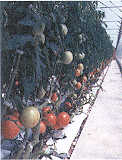The demand for premium produce is so high in the US that the number of current hydroponic farms cannot meet
the demand. Every day hundreds of thousands of pounds of hydroponic
tomatoes, peppers and cucumbers are flown in from Canada, Europe and Mexico.
In addition to the commercial applications of hydroponics, there are many home gardeners that maintain
hydro-
ponic systems. Because more crops can be grown in a small space, it is environmentally friendly and produces premium produce, hydroponic culture lends itself well to a
small garden. A hydroponic garden can be set up indoors, in a windowsill, a patio, balcony or rooftop, making gardening available to those who do not have a traditional yard or access to soil.
The US Navy is growing fresh vegetables on submarines in highly specialized recirculating hydroponic systems
to help supply fresh vegetables for the
crews.
NASA is experimenting with recirculating hydroponic systems to be
used to feed people in space. Many experiments have been conducted in laboratories and on recent space shuttle missions.
With today's technology, a small hydroponic grower with just 5,500 square ft. of greenhouse space (that's 1/8th
of an acre) can grow as much as 50,000 lbs. of hydroponic tomatoes
annually.
As a concept, hydroponics has been around since the beginning of time. As a science, it is quite new.
Hydro-
ponics has only been used in commercial production for approximately 50 years.
In that time, it has been applied to both indoor and outdoor farms, to growing premium produce, to feeding
third world countries and to applications in the space program.
The Future of Hydroponics
As the technology is refined, hydroponics may become even more productive, feeding people around the world
or even in space. Other areas where hydroponics could be used in the future include growing seedlings for reforestation, establishing orchards, growing ornamental crops, flowers and shrubs and integration with
aqua-
culture, where the wastes provides nutrients to the plants and the plants help to purify the water the fish are living
in.

HOME / LAST
PAGE / NEXT PAGE

